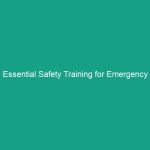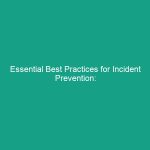Good Morning Team
Today, we’re going to talk about an essential topic that impacts all of us: Essential Change Management: Assessing Safety Impacts of New Processes. This discussion is crucial for maintaining a safe working Environment as we introduce new processes and Procedures. Understanding and managing changes effectively is vital to ensuring our workplace remains safe, efficient, and compliant with Safety Standards.
Understanding Essential Change Management
Essential change management refers to the systematic approach to dealing with changes in the workplace, particularly focusing on how these changes affect safety. It involves assessing potential risks and implementing strategies to mitigate them before any new processes are rolled out.
When we introduce new equipment, procedures, or technologies, it can significantly impact our daily operations and safety protocols. Many employees might feel that changes won’t affect them directly, but it is essential to recognize that every new process can introduce unforeseen Hazards.
One common misconception is that change is inherently bad. However, with proper management and assessment, change can lead to improved safety, efficiency, and productivity. By effectively evaluating the safety impacts of new processes, we can ensure that our workplace remains safe for everyone.
Key Hazards, Risks, and Safety Considerations
Every new process or change can introduce specific hazards, such as:
- Inadequate Training: Employees may not be familiar with new procedures or equipment, leading to mistakes or accidents.
- System overload: New processes may increase the workload on existing systems, causing fatigue or equipment failures.
- Increased complexity: More steps or procedures can lead to confusion, increasing the risk of safety oversights.
If these hazards are ignored, the consequences can be severe. For instance, a lack of proper training can lead to accidents, injuries, or even fatalities. Additionally, increased workloads can contribute to employee burnout and decreased morale.
Best Practices, Procedures, & Actionable Advice
To ensure safety during any change, follow these Best Practices:
- Conduct a thorough risk assessment: Before implementing any new process, evaluate the potential safety risks involved. Identify what could go wrong and how those risks can be mitigated.
- Involve employees in the change process: Engage with team members who will be affected by the changes. Their insights can help identify potential hazards and create practical safety solutions.
- Provide comprehensive training: Ensure all employees receive adequate training on new processes and equipment. This training should be ongoing, with refresher courses as needed.
- Monitor and review: After implementing changes, continuously monitor the process for any unforeseen safety issues. Be open to feedback and willing to make adjustments as necessary.
For example, consider a company that introduced new machinery without proper training. Several employees operated the machines improperly, leading to a serious injury. By involving workers in the decision-making process and providing thorough training, the company could have avoided this incident entirely.
Regulations, Standards, and Compliance
It’s essential to be aware of relevant safety Regulations and standards, such as those set by OSHA (Occupational Safety and Health Administration) or ISO (International Organization for Standardization). Compliance with these regulations is not just about avoiding fines; it’s about ensuring a safe working environment for everyone.
Being compliant with safety standards protects employees from potential hazards and contributes to the organization’s overall efficiency and reputation. Always stay informed about any changes in regulations that may affect our processes.
Employee Engagement & Discussion
Now, let’s open the floor for discussion. Consider these questions:
- What safety challenges have you encountered related to changes in processes?
- How can we improve our communication about changes that affect safety?
- What additional support or resources do you think would help during transitions?
Your experiences and insights are invaluable in creating a safer workplace, so please share your thoughts.
Conclusion & Key Takeaways
In summary, effectively managing change is crucial for maintaining safety in our workplace. By understanding the impacts of new processes, assessing risks, and implementing Best Practices, we can prevent accidents and ensure everyone’s safety.
Let’s all commit to prioritizing safety as we navigate changes together. Thank you for your attention and for your ongoing commitment to creating a safe work environment for all.


